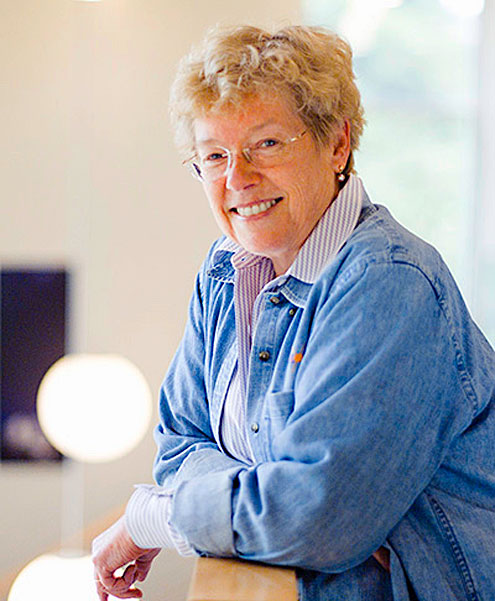UCSC Astronomer’s Ground-Breaking Studies of Galaxies Helped Establish Many of the Foundational Principles of Modern Cosmology
By Tim Stephens

Faber, who received the National Medal of Science in 2013, is renowned for her contributions to the understanding of dark matter, galaxy formation, and the large-scale structure of the universe. She will receive the Gruber Prize at an award ceremony this fall.
The award citation praises Faber for “her groundbreaking studies of the structure, dynamics, and evolution of galaxies,” that has led to the study of dark matter, the relationship between dark matter and the formation of galaxies, and that black holes reside at the heart of most large galaxies. Her contributions led to innovations in telescope technology that have revolutionized modern astronomy. With these myriad achievements Faber has, “aided and inspired the work of astronomers and cosmologists worldwide.”
A partial summary of her achievements includes:
1979 – Faber and John S. Gallagher published a paper that provided a review of the evidence for the existence of dark matter. This paper is regarded as the turning point in the debate about whether 80 percent of the mass in the universe is “missing”—mysterious, invisible, and impervious to direct detection.
1983 – Faber’s discovery of large amounts of dark matter in an exotic species of galaxy concluded in a paper with UCSC astronomer Douglas Lin, that dark matter could not be neutrinos, a subatomic particle that travels close to the speed of light but might be another subatomic particle, not yet known, that travels at a much slower rate.
1985 – Faber was the leading science advocate for the construction of the 10-meter Keck telescope in Hawaii (the most powerful on the planet when it went online in 1993) and, with UCSC astronomer Harland Epps, developed the optical design. (UCSC astronomers Jerry Nelson and Terry Mast also made important contributions to the Keck telescope design.) Faber later lead construction of the DEIMOS spectrograph on Keck, one of the largest and most innovative astronomical instruments in the world.
1985/86 –Faber was a member of the collaboration developing the Wide-Field Camera for the Hubble Space Telescope. (The only astronomer known to play a major role on both Keck and Hubble.) After the launch of the telescope she and Jon Holtzman diagnosed the spherical aberration that compromised the telescope’s image quality.
1988 – Faber was the principal investigator among a collaboration (the so-called Seven Samurai) that discovered irregularities in the rate of the universe’s expansion that apparently depends on the distribution of matter, and the distribution of gravitational effects in our universe.
1985/2002 – Faber served as the principal investigator for a collaboration that came to call themselves the “Nukers”—because they were studying the nuclei of galaxies. Among the discoveries were made under Faber’s leadership, were that the center of every large galaxy harbors a massive black hole and that the mass of that central black hole closely correlates to the orbital speed of stars within the galaxy.
2010 to present – Faber has served as co-principal investigator, with Henry Ferguson, on the CANDELS (Cosmic Assembly Near-infrared Deep Extragalactic Survey) collaboration, the largest project of the Hubble Space Telescope. Over more than 900 Earth orbits the team collected data on the most distant, and therefore the youngest, galaxies. By comparing those data with the data about galaxies near to us, astronomers can trace the evolution of galaxies throughout cosmic time.
As a body of work, these advances and discoveries have helped define how scientists think about and investigate galaxies and superclusters of galaxies, the largest structures in the universe.
For Faber her work has also helped define how civilization can conceive of its place in the cosmos. In recent years she has become a prolific public speaker, providing a cosmic perspective on our planet and urging audiences to consider humanity’s “custodial responsibility” for the Earth, which she calls “a jewel of the universe.”
•••
Faber joined the faculty at UC Santa Cruz in 1972 and in 1995 was made University Professor, the highest honor for faculty in the UC system. A member of the National Academy of Sciences, American Academy of Arts and Sciences, and American Philosophical Society, she has received many awards and honors in recognition of her accomplishments. She earned her bachelor’s degree in physics at Swarthmore College and her Ph.D. in astronomy at Harvard University.
The Yale-based Gruber International Prize Program annually honors individuals in the fields of cosmology, genetics, and neuroscience for groundbreaking work that inspires and enables fundamental shifts in knowledge and culture.